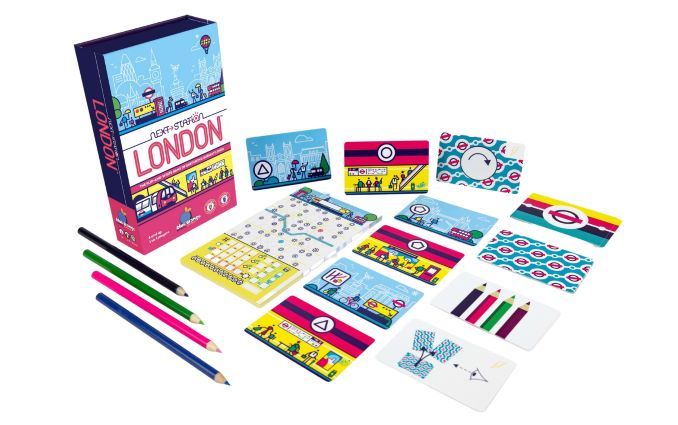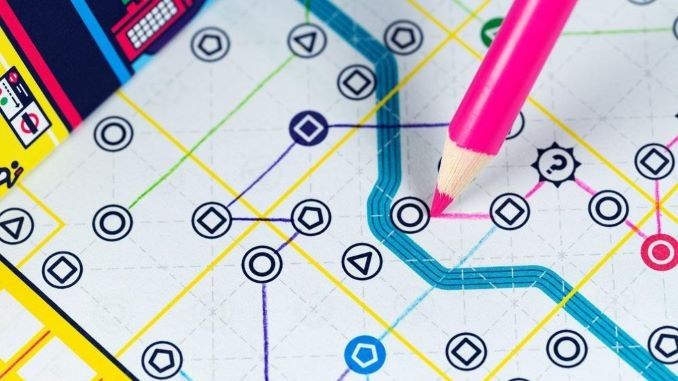Next Station: London is a new route-finding, puzzle-like flip-and-write game from Matthew Dunstan, designer of Elysium, Relic Runners, and this year’s Vivid Memories, and I think it’s the best thing he’s ever done. Taking its basic mechanic from Silver & Gold, Next Station: London asks you to link stations on your scoresheet to try to max out your score for each route—but each line you draw reduces your options for later in the game.
For a quick refresher: A flip-and-write game gives every player a scoresheet of some sort—maybe just one, maybe a few—and a pencil or a dry-erase pen. Someone flips over the next card in the deck, and every player uses whatever is on that card to mark off something on their scoresheet(s). Some games give you more than one option per turn, like the great Welcome To…, while some give you several scoresheets to use at a time, like Silver & Gold and Super Mega Lucky Box. But the core idea is always the same: Someone flips, and everyone writes.
Next Station: London follows that same basic framework and adds a few new twists. One is that there are four potential routes you can draw on your scoresheet, represented by four colors—one starting point in each color on your scoresheet, and one pencil in each color. The game has four rounds, and in each round, you’ll get a different pencil, so in that round you’ll be the only person working on that particular route. That means that the game will unfurl differently for every player; you can’t all make the same choices every turn because you won’t get the same sequence of cards when working on your purple route as other players will.
The stations on your scoresheet appear as four different shapes, and some are also starred as tourist sites. For each round, the players will cycle through some or all of a deck of 11 cards showing those shapes—two cards for each shape, one red and one blue; two wild cards that can be used for any shape, again one red and one blue; and a branching card. When a regular card appears, you may extend your current subway line in either direction to a space matching the shape on that card. When the branch card appears, you flip the next card, and then players may, if they choose, branch from anywhere on their current route to a matching station. The possible connections between stations are shown via dashed lines on your scoresheet, and your route may not cross an existing line you’ve already drawn, and may not double a route back on itself.

The catch is that the round ends when the fifth red card appears, regardless of how many cards in total you’ve been through so far. So some rounds will let you add up to 10 stations to your route, while some can add as few as five. You can plan as much as you’d like, but the deck ends when it ends—you draw a line to a matching station and then you get the next colored pencil.
Your scoresheet has 13 areas on it, which can have anywhere from one to six stations in them. The points you score for a route are the product of the number of areas that route visits and the highest number of stations visited in any single area. In the base game’s rules, that puts the maximum score at 30 points just for the stations. You also get to add two points every time your route crosses the Thames river, which runs east-west across the middle of your scoresheet, and mark off one circle on the scoring track at the bottom of your scoresheet every time you connect a route to a tourist site. (You can visit one site multiple times.) You also get a bonus if you connect two or more routes at a single station, more if you get three or even all four routes to do so.
You may also play with two common objective cards that allow players to score 10 points for some additional achievement that might be at odds with maximizing the scoring of individual routes. One asks you to visit all five tourist sites on your scoresheet, while one—the hardest, I think—requires you to get your routes to visit all 13 areas on the board. There’s also an advanced mode that uses “pencil powers,” one of which is available in each round, such as letting you draw a second line for the same card or letting you treat the flipped card as a wild rather than a specific shape.
Flip-and-writes and their ancestors roll-and-writes give you the benefit of a very familiar puzzle in every game that plays out differently because the sequence of permitted moves changes every time. In Next Station: London, though, the scoresheet is limited enough that almost every choice you make, even early in the game, will start to restrict your options for the remainder of the game—a bit like Cartographers, but faster to play and thus faster to get you to the point where you have one choice left, or none at all. That central conflict, between the desire to maximize your points early in the game and the need to maintain some flexibility, is the best part of the game. It’s a puzzle that keeps me coming back to play it again and again.
Keith Law is the author of The Inside Game and Smart Baseball and a senior baseball writer for The Athletic. You can find his personal blog the dish, covering games, literature, and more, at meadowparty.com/blog.

